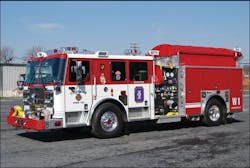The Citizens Fire Company #1 in Lebanon County, PA, operates from a single fire station located in the Borough of Palmyra. The station is located at 21 North College St. and is under the command of Chief Dave Dugan. Company 1 protects approximately 7,200 residents in the borough as well as the areas within North Londonderry Township. The station responded to 711 calls during 2009, including runs with neighboring Lebanon County departments in Campbelltown and Annville as well as the Hershey Fire Department in nearby Dauphin County.
In the past the Citizens Fire Company operated a fleet of Mack apparatus including a classic 1954 B model quad together with a 1959 Mack B model 1,000 gpm pumper. During the 1970's the department placed into service a 1973 Mack CF 1,000 gpm pumper as Engine 1 with a Mack CF 1,000 gpm pumper being acquired during 1979. In later years this unit was rebuilt by the Swab Wagon Company with a four-door cab enclosure and body modifications including an FDNY style Conestoga hosebed cover. This unit was recently retired from service with the acquisition of the new Wagon 1.
The station's current apparatus includes Rescue Engine 1-2, a 2006 American LaFrance Eagle chassis with bodywork by RD Murray that is equipped with a 2,000 gpm pump, 750-gallon water tank and a full compliment of rescue tools, together with Tower Ladder 1, a 2005 American LaFrance/LTI 100-foot midship tower that carries 194 feet of ground ladders with a 1,750 gpm pump and a 200-gallon water tank. The fire company also operates a 2001 Ford F-350 four door cab with a Phoenix utility body and two command vehicles for use by the chief officers.
The host for our visit to Palmyra was Chief Engineer Doug Boltz who described the department's newest addition - Wagon 1. This engine apparatus was designed by eight members of the fire company's apparatus committee. The apparatus is based upon a 2009 Seagrave Marauder II cab and chassis with a 190.5-inch wheelbase with an overall length of 31 feet 10 inches. The unit is powered by a Detroit Diesel Series 60 engine rated at 470 horsepower through an Allison EVS-4000 transmission. The stainless steel cab provides seating for six personnel with forcible entry tools and a water extinguisher safely secured within a roll up door compartment inside of the cab. A second enclosed compartment inside of the cab carries EMS equipment.
Multiple Pre-Connected Hoselines
The firefighting capability of this apparatus is provided by a Seagrave Triton single-stage pump rated at 1,500 gpm which can supply any of the eight pre-connected attack lines on the unit. The steel reinforced front bumper is finished in red Linex and is equipped with a five-inch front suction with a 2.5-inch discharge. A gated wye supplies both a 150-foot and a 200-foot pre-connected 1.75-inch attack lines at the front bumper, each of which are equipped with a Task Force automatic nozzle.
The pump panel on both sides of the apparatus is also finished with Linex material for increased durability and to reduce maintenance.
Four crosslay beds are positioned low ahead of the pump panel providing easy deployment of these lines from each side of the apparatus. Each of the pre-connected hoselines are color coded both on the pump panel gauge and the controlling gate, to minimize confusion on the fireground. These beds carry three 200-foot 1.75-inch attack lines together with one 200-foot 2.50-inch attack lines. The nozzles on the crosslay beds are a mixture of Task Force automatic nozzles and smooth bore handline nozzles. The initial attack capability of this unit is provide by an L-shaped 750-gallon water tank which provides a low hose bed at the rear of the engine.
In addition to the bumper and crosslay attack lines, Wagon 1 is equipped with two additional pre-connected lines consisting of a 300-foot 1.75 inch attack line and a 200-foot 3-inch leader line which is equipped with a water thief. The rear hose bed also carries a 200-foot 1 3/4-inch line and a 200-foot 2 1/2-inch attack lines that can be easily advanced in conjunction with the 3-inch leader line.
The supply line hosebed is equipped with 1,200 feet of 5-inch supply line which has a different color length at the 600-foot mark of the supply line bed to assist the engineer in determining the number of lengths that have been used at a particular incident. In addition a Task Force Blitz Fire tailboard gun is attached to 500 feet of 3-inch hose with loops at each 100-foot interval for use as a rapidly deployable 500 gpm master stream device. Wagon 1 carries an additional portable monitor in a rear body compartment together with a top mounted, pre-connected deck gun equipped with smooth bore tips. Given the variety of pre-connected attack lines and the multiple master stream capability on Palmyra Wagon 1, this apparatus provides a great degree of both handline and master stream capability on the fireground.
Standard Equipment Around The Body
Beyond the fire pump and hoseline capabilities Wagon 1 is equipped with a Harrison 15.0 Kw hydraulic generator which is mounted over the fire pump. The generator supplies power to a top-mounted electric cable reel in addition to several body mounted 120-volt outlets. Scene lighting is provided by three cab-mounted Kwik Raze lights in addition to four 900 watt lights mounted on the body and at the rear of the cab.
Emergency lighting includes five short light bars mounted on the cab roof with Whelen LED warning lights around the perimeter of the engine. Additional front warning lights include two pedestal Mars lights together with a roto-ray light on the cab grill.
The stainless steel pumper body is provided with six enclosed compartments which carry the basic engine company equipment, together with 48 feet of ground ladders and two lengths of hard sleeve which are mounted on the right side of the apparatus. One of the unique features on the apparatus is a FDNY style hosebed cover with a fixed rear canopy at the rear step. The cover can retract on slides to allow personnel to easily stand in the hosebed when re-loading hose. The front left compartment door is reverse hinged to allow better access to fittings and appliances for the pump operator.
Several safety related items include the use of a down view mirror above the right front windshield, side cornering lights at the front bumper and a recessed arrow stick light below the rear hosebed. Hand holds are provided on each of the hose bed dividers to make it safer to access this area of the apparatus. The four-way hydrant valve and Blitz Fire gun are mounted low at the rear of the apparatus to allow personnel to deploy these appliances without having to climb onto the engine.
From bumper to back step Palmyra Wagon 1 is an excellent example of a well thought out and developed engine company. Whether your department serves a built up urban area or a rural area without benefit of hydrant protection there are several thoughts and ideas that you can borrow from this unit to enhance the tactical capabilities and safety of your members from this innovative engine apparatus.
I would like to acknowledge the assistance of Chief Dave Dugan of the Citizens Fire Company #1 and Engineer Doug Boltz for their kind help with this article.
TOM SHAND is a 37-year veteran of the fire service having served with departments in Maryland, Pennsylvania and New York. He has worked in the fire apparatus industry since 1985, including 15 years with Saulsbury Fire Apparatus. He is a contributing editor to Fire Apparatus Journal and Firehouse Magazine and works with Mike Wilbur at Emergency Vehicle Response. He co-hosts the Apparatus Architects podcast with Wilbur, based on their column in Firehouse Magazine.
About the Author

Tom Shand
TOM SHAND, who is a Firehouse contributing editor, is a 36-year veteran of the fire service. He works with Michael Wilbur at Emergency Vehicle Response, consulting on a variety of fire apparatus and fire department master-planning issues. Shand is a member of the Firehouse Hall of Fame.
